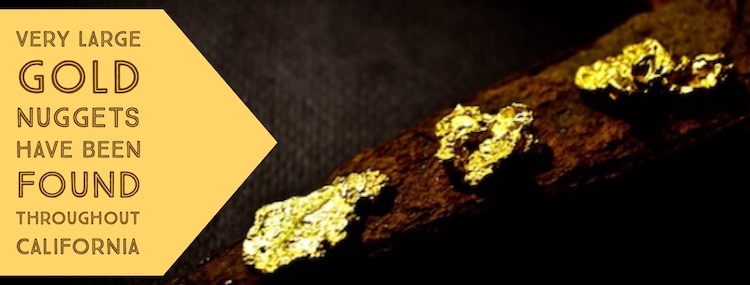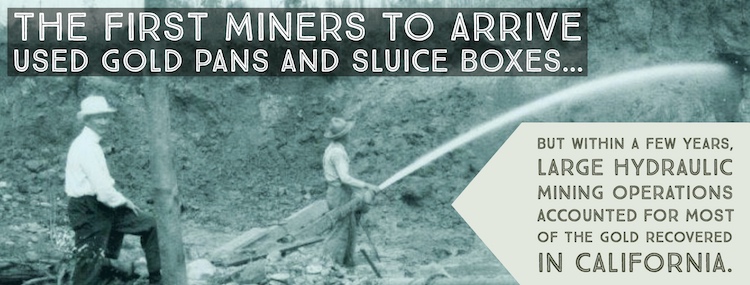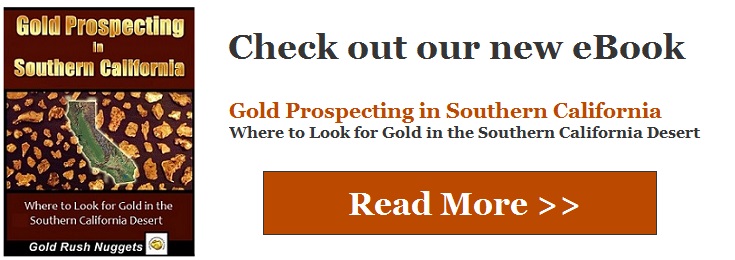Gold mining in California had a huge impact on the rapid development of the state and creation of wealth. Although production has diminished over the years, current exploration across the state is a pointer to the extensive gold mineralization that can still be exploited by prospectors.
A Brief Overview of Gold in California
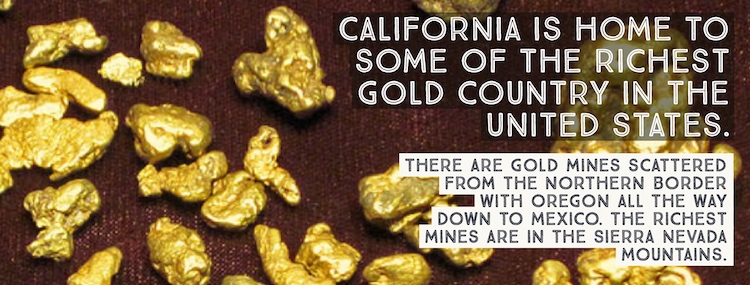
It is no secret that California is the most gold rich state in the U.S. Ever since the first discovery of gold at Sutter’s Mill in 1848, there have been thousands upon thousands of gold seekers coming to California in search of riches. By 1965, more than 100 million ounces of gold had been produced in the state from thousands of placer deposits and over 22,000 mines.
While other states have ramped up their production over the years, recent exploration efforts in California indicate that there are numerous projects with strong growth projections.
On a much smaller scale, there are thousands of prospectors armed with nothing more than shovels, picks, pans and metal detectors who are also having success in California to this very day.
Of course it is the famous “Mother Lode” region of northern California that is best-known for gold. The extent of the gold occurrences in this part of the state makes it one of the largest goldfields on earth.
While the world famous deposits in the Mother Lode garner the most attention, there are actually rich gold deposits that can be found all throughout the state. In fact, if you live in California, you are likely to be within just a few hours at most from good gold country.
Below we will outline three primary areas where gold can be found throughout the states.
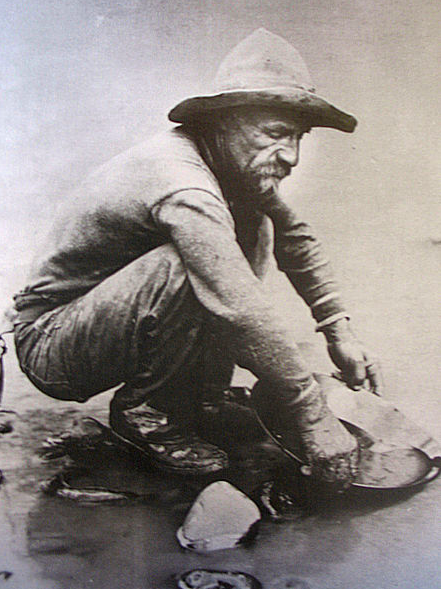
The iconic California gold rush miner.
Far Northern California – “The Northern Mines”
There are some extremely rich gold deposits in the far northern part of California. The old-timers referred to this area as the “Northern Mines,” as they were located a good distance north of the Mother Lode.
Most of the mining in this region was concentrated in the Klamath Mountains and in the river systems that drain the area.
This region gets significantly less attention than many parts of California, yet there are still some exceptional prospecting opportunities to be found here.
The number of placer claims in the region has been increasing considerably as prospectors realize the potential that has been ignored for long. It’s notable that where past successes were recorded, there is always a likelihood of noteworthy and profitable mining today.
This region is located just south of the Oregon border; in fact it because of its similar geology it could really be considered a continuation of southwestern Oregon’s pocket gold county.
The main drainages here are the Klamath River, as well as the headwaters of the Sacramento River. The region is primarily contained within Shasta, Siskiyou, and Trinity Counties. Good prospecting can be found around Redding, Yreka, and many of the smaller towns here. There are many remote areas here that still hold fantastic potential for gold.
The areas along the Klamath River were mined as early as the 1850s and Tthey quickly became some of the most productive. Most parts of the river are rich with placer deposits, especially the stretch along Highway 96 towards the town of Orleans. The area around Yreka and French Gulch had some of the richest deposits. The river’s tributaries such as Humbug Creek are also productive.
The Salmon River on the other hand flows through some rich gold-mining areas and was famous for abundant placer deposits at Cecilville on the South Fork, Eddy’s Gulch and Sawyer’s Bar on the North Fork as well as the junction of the two forks.
The areas west of Weaverville have reported good placer deposits especially along Trinity River. While most of the production in the vicinity of the river came from hydraulic mines, many placer deposits in the river and its tributaries such as Canyon Creek are substantially endowed with gold.
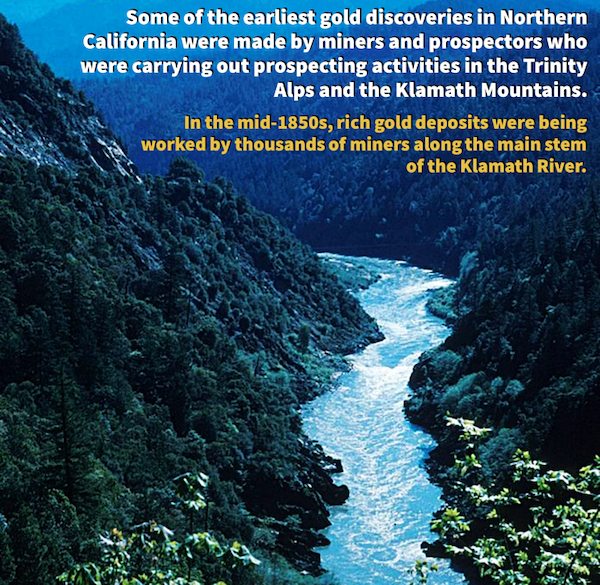
Northern California’s “Mother Lode”
When gold prospectors refer to northern California, they are generally talking about the rich gold country of the Sierra Nevada Range. This is the famous region that thousands of ‘49ers flocked to in search of gold. And they found lots of it.
Gold can be found just about anywhere in this part of the state. Major rivers here include the Feather River and American River, along with nearly all of the rivers and creeks that flow into the Lower Sacramento and Lower San Joaquin Rivers.
Nevada, Sierra, Plumas and Placer counties are the most prominent in terms of production. They encompass large areas of the Mother Lode where thousands of historical gold mines are located. They also represent the most active modern-day placer mining with thousands of active placer claims.
Plumas County has several areas that produce gold in abundance. The mining districts of Foresthill ($25 million in production), Michigan Bluff, Quincy and Butte Valley have provided rich placer deposits to date.
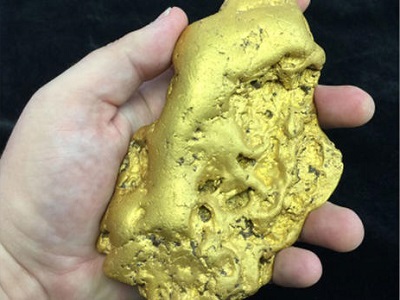
The “Butte Nugget” was discovered in 2014 in Butte County. It sold to an undisclosed buyer for $400,000!
Large swathes of Feather River and its tributaries have been extensively mined yielding large amounts of placer gold. The North Fork of the river has placer deposits near Belden. Indian Creek, a tributary of the Feather River has some very productive placers at Rich Bar.
The western slope of the Sierra Nevada that borders Feather River stretching southwards to the Merced River produced the bulk of the gold in the state.
Another rich gold district in Plumas County that has placer deposits is La Porte which produced $60 million between 1855 and 1871, largely attributable to hydraulic mining. The lower part of the Yuba River northeast of La Porte has some good concentrations of placer gold.
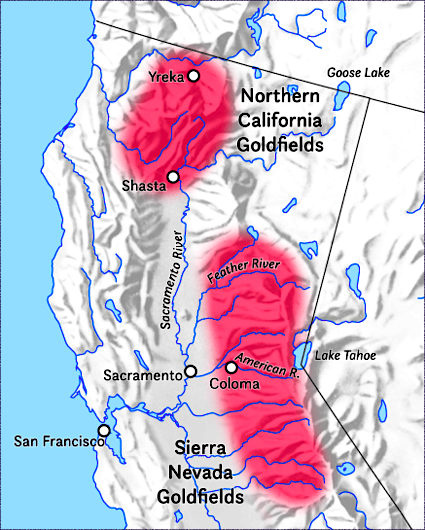
The Northern California goldfields are some of the most expansive on Earth. Rich mineralization spans an area that covers thousands of square miles in total.
In Sierra County, Alleghany and Downieville districts had the richest placer mines. Staked claims in the Downieville area have increased over the years making it one of the districts that are still active.
Poker Flat District, located about 10 miles north of Downieville, was a placer-mining area with streams and mines awash with gold. Hydraulic mining was introduced in the 1850s and the Howland Flat mines produced gold valued at $14 million.
Nevada County was the site of some of the largest hydraulic mines in the world that operated in the 1800s including the famous Malakoff Mine. Lowell Hill, Washington and North Bloomfield districts have active placer mines that have produced gold consistently.
Nevada City district is in the western part of the County and covers an area with both lode and placer mines. The district’s first Gold was extracted from Deer Creek.
The extent of gold occurrence in the Mother Lode region is unparalleled to anywhere in the United States.
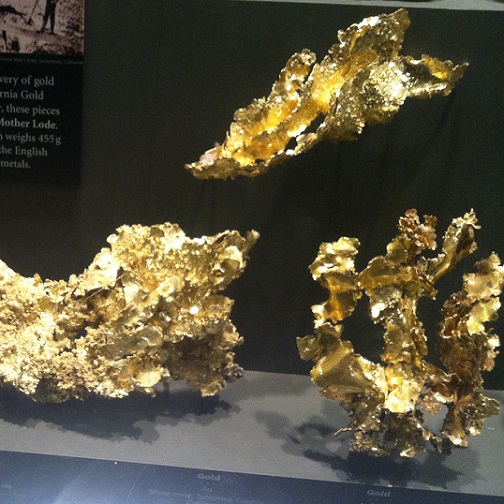
Some of the spectacular crystalline gold specimens on display at the Smithsonian Museum in Washington D.C. These come from the Sierra Nevada Mountains in Northern California.
The geologic conditions produced an amazing amount of lode gold deposits, which even today still hold great potential for prospectors. And it is these lode occurrences that feed the countless placers in the creeks, rivers, and gulches throughout the Mother Lode.
Although cost of production limits some of the gold mining in California today, it is really the political and environmental limitations that affect the gold output today. Much of the gold found today is by individual prospectors, but even small-scale methods like suction dredging are currently banned in the state.
Some of California’s largest gold nuggets have been found using metal detectors.
Southern California Gold Deposits
The southern half of the state seems to get very little attention from gold prospectors. Certainly it is not as rich as the gold country in the northern half, but there are still some fantastic gold prospecting opportunities here. Part of this region is largely a desert and on the western side is covered by the California Coastal Ranges.
The Rand district is the most notable gold producer in this region. It has placer deposits and is popular with prospectors who use metal detectors. Early exploration was reported in the 1860s but placer gold was discovered in the district at Goler Wash in 1893.
With a total gold output of more than $20 million, the district attracts a lot of prospecting activities evidenced by the increasing number of claims in the areas around Goler Wash and near the Yellow Aster Mine which produced most of the gold in Kern County.
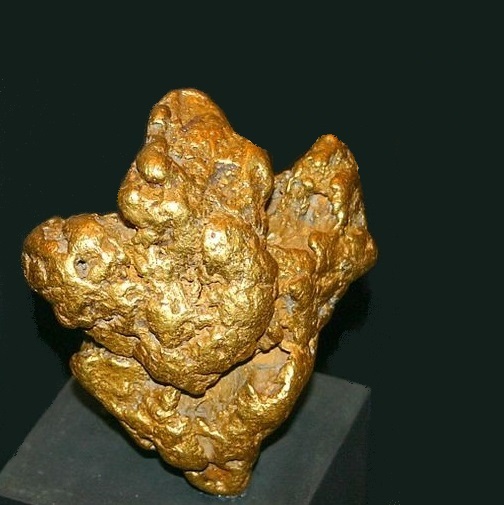
The Mojave-Rosamond district is located in southeastern Kern County. Gold was discovered on Standard Hill in 1894. The Cactus Queen mine dominated the district after it was discovered in 1934. The district’s namesake, the famous Mojave Nugget, (it weighed 156 troy ounces!) was found in southern California with a metal detector. Many other huge nuggets have been found here as well.
Acton district in Los Angeles County covers the San Gabriel Mountains where gold was discovered in 1834. Lode mining was introduced later in the 1870s with moderate success. Although it is far from being the richest area in California, it is an extremely popular area due to its close proximity to Los Angeles. Unfortunately, much of this land is now off-limits due to a recent land designation.
One of the noteworthy areas in Southern California is the Dale mining district located near 29 Palms. It is a very productive area to find gold. Extreme temperatures limit prospecting in the summer, but in the winter many prospectors explore the hills in search of gold.
With limited water, it is metal detectors and drywashers that are primarily used here.
The Kern River is another rich area that drains the very southern flank of the Sierra Nevada Mountains. This is a popular mining area for people located in the Bakersfield area.
The Kern River district continues to attract active placer claims despite the fact that the first discovery of gold happened way back in 1851 on nearby Greenhorn Creek. Many lode prospects have been worked in the district but the Gem Gold Mine is the only significant lode deposit in the area.
Conclusion
California may not be what it used to be during the gold rush era. However, being the most well known state for gold mining in the U.S. and given the operating mines and prospects, it is an exciting region to explore as the price of gold continues to be stable.
A spectacular amount of gold has been found in California over the years, and despite environmental restrictions that have been put in place over the recent years, there is still plenty of gold being found. The restrictions notwithstanding, today’s miners can embrace the spirit of the early prospectors but do it in a more responsible manner.
Basic prospecting equipment like gold pans, sluice boxes, and highbanker can be used to recover placer deposits from creeks and rivers. And metal detectors can be used to locate gold nuggets from ancient river channels and bench deposits located high above the existing water line.
It’s important to note that most of the old mining areas were abandoned because mining became unprofitable due to external factors and not due to depleted gold. More companies are exploring and developing several deposits and deploying advanced mining techniques across the state.
The takeaway of this article should be that there are countless areas in California that you can still find gold, and not just in the Mother Lode. There are literally thousands of places from the top of California to the bottom where gold can still be found!
Next: Spring Flooding in California Will Add More Gold to the Rivers
Plus: 7 Places to Look for Gold in the Southwest this Winter
And: 77 Gold Prospecting Tips

